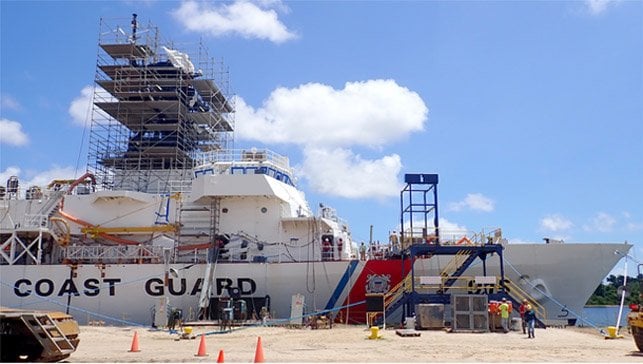GAO Repeats Criticism of the USCG Program to Build Offshore Patrol Cutters

The Government Accountability Office has issued a new report on the U.S. Coast Guard’s program to build the Offshore Patrol Cutters and once again has criticized the approach and ballooning costs of the program. It is the third report developed by the GAO on the program and reiterates many of the same concerns that were raised in 2023, while also pointing out that no ships have yet been delivered and the uncertainties in the program.
The new audit was undertaken for the House of Representatives’ Committee on Transportation and Infrastructure and was released on November 25. The GAO again warns that the Coast Guard has “employed a high-risk approach” and that it is taking steps “contrary to shipbuilding leading practices.” The GAO concludes that it “increases the risk of negative outcomes, such as cost growth and schedule delays.”
The program, which is recognized as the highest investment priority, it notes, is already significantly behind schedule and has experienced large cost increases. GAO warns the program risks further delays and costs while recommending steps to manage the ongoing effort.
The report details that the program is nearing its 12th anniversary, as the Coast Guard awarded the preliminary design work in February 2014. Eastern Shipbuilding Group was selected in September 2016 and two years later received the first contract for the first vessel. ESG ultimately received a contract for the first four vessels, and the second phase was won by Austal USA in June 2022.
GAO has repeatedly criticized the Coast Guard for moving forward without a stable design. They concluded that this has resulted in rework, which has increased the cost and delayed the ships. Even at this point, it found that “each shipbuilder’s design remains incomplete.”
It says that this approach involves significant overlap in technology development, design, and construction. The Coast Guard has not agreed and continues to push the program forward.
The report recommends that the Coast Guard Commandant should ensure that the design is stable before any more vessels start construction. It also calls for a memorandum to agree on how the evaluation of deficiencies will be coordinated.
The plan for the project also calls for incorporating testing results from the first vessels into the development of the third stage, after the construction of up to 11 vessels by Austal. The GAO finds that with the delays, it is unlikely that the test results would be available before the start of procurement activities for stage three. The report calls on the Department of Homeland Security to direct the Coast Guard to document a plan for acquiring stage three that identifies how results from operational testing of stages one and two will be incorporated into stage three procurement activities, such as developing the request for proposals, and contingency plans if this testing is delayed.
The GAO is also critical of the cost accounting being used, noting that the program “uses outdated cost information.” It also accounts for all 25 planned vessels instead of by stage. They believe reporting by stage would enable decision-makers to establish better accountability in the program.
The cost of the program, the report says, increased by 41 percent between 2012 and 2022, and delivery of the first vessel slipped by 1.5 years. The total cost is reported to have risen from $12.5 billion to $17.6 billion.
The report highlights the urgent need for the new vessels, noting that the current Medium Endurance Cutters will have exceeded their 30-year design service lives. It notes that the existing vessels are increasingly difficult and costly to maintain at a time when there is growing demand on the Coast Guard to support migrant and drug interdiction increases. It notes that in July 2025, the Coast Guard received an additional $4.3 billion for the procurement of the Offshore Patrol Cutters to support the expansion of the mission.
GAO concludes that the current processes remain risky. It makes recommendations to enhance the process to reduce further cost increases and improve the timeliness of future vessel deliveries.
